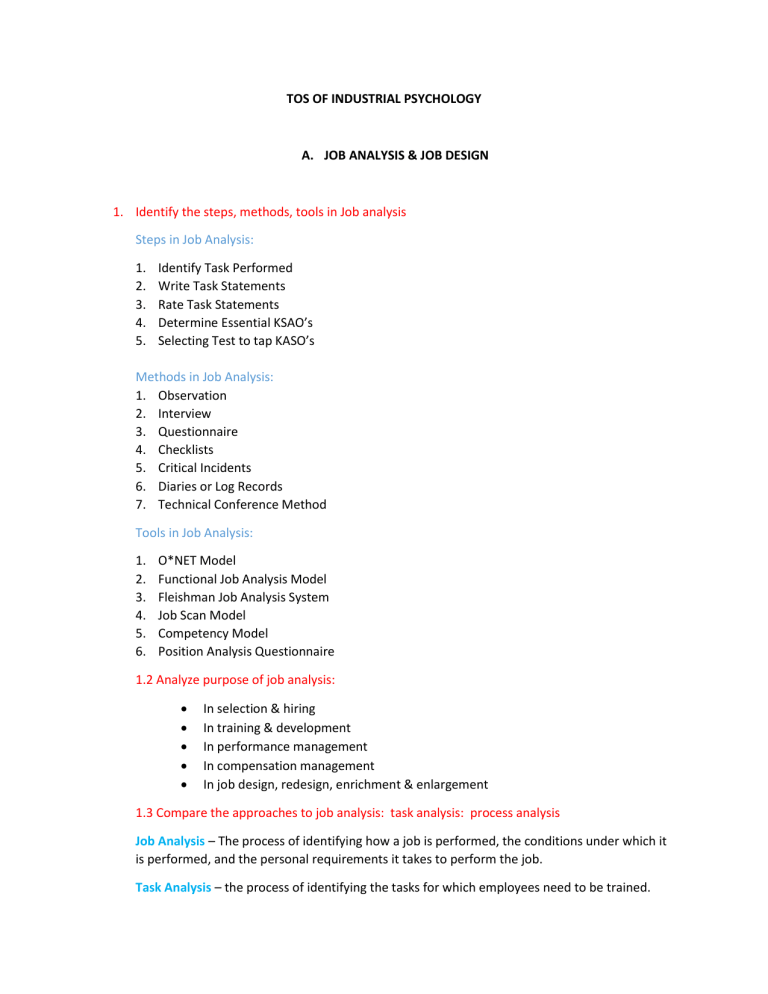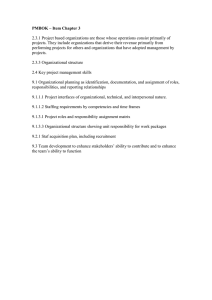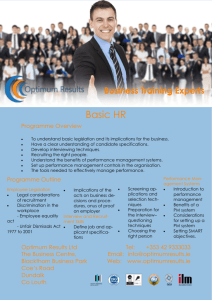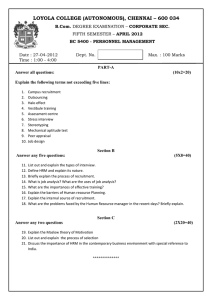
TOS OF INDUSTRIAL PSYCHOLOGY A. JOB ANALYSIS & JOB DESIGN 1. Identify the steps, methods, tools in Job analysis Steps in Job Analysis: 1. 2. 3. 4. 5. Identify Task Performed Write Task Statements Rate Task Statements Determine Essential KSAO’s Selecting Test to tap KASO’s Methods in Job Analysis: 1. Observation 2. Interview 3. Questionnaire 4. Checklists 5. Critical Incidents 6. Diaries or Log Records 7. Technical Conference Method Tools in Job Analysis: 1. 2. 3. 4. 5. 6. O*NET Model Functional Job Analysis Model Fleishman Job Analysis System Job Scan Model Competency Model Position Analysis Questionnaire 1.2 Analyze purpose of job analysis: In selection & hiring In training & development In performance management In compensation management In job design, redesign, enrichment & enlargement 1.3 Compare the approaches to job analysis: task analysis: process analysis Job Analysis – The process of identifying how a job is performed, the conditions under which it is performed, and the personal requirements it takes to perform the job. Task Analysis – the process of identifying the tasks for which employees need to be trained. Process Analysis – is a systematic review of all steps and procedures followed to perform a given activity. 1.4 Describe the outcomes of job analysis: Job description Job specifications 1.5 Examine the importance of Job Design Jobs that are well designed are based on principles that result in a more efficient and effective workforce. Improving Job Design reduces employee Job Stress, Negative Health Implications, and Absenteeism. B. RECRUITMENT & SELECTION 2.1 Recognize the importance and benefits of a strategic recruitment and selection system 2.2 Differentiate: Core competencies vs Functional Competencies Core competencies Ex. Decision Making, Teamwork, Work Standards, Reliability, Motivation, Adaptability, ProblemSolving, Integrity, Communication, Planning & Organization, Stress Tolerance, and Initiative Functional Competencies – technical competencies – these are the skills that professionals are required to use on a daily or regular basis. Ex. Risk Analysis, Data Analysis, Programming, Accounting, Psychology Job Competencies vs Position Qualifications Job Competencies KSAO’s needed to perform the job Ex. - Must have highschool diploma - Understand Financial Documents - Skilled in using Microsoft Excel - Have advanced coursework in accounting and finance Position Qualifications 2.3 Identify the different stages of the recruitment process 1. Job Analysis 2. Selection of testing methods 3. Test Validation 4. Recruitment 5. Screening 6. Testing 7. Selecting 8. Hiring / Rejecting 2.4 Compare: Job-fit: Person-Environment Fit: Competency-Based recruitment & selection Job fit – the compatibility of employee’s ability and the job demands Person-Environment Fit - the compatibility of employee with his work environment 2.5 Analyze the major principles and issues in recruitment and employee selection (objectivity, inclusivity, freedom from biases, stereotypes, discrimination) Discrimination: Race Color Sex National Origin Religion (Days of Worship, Worship Practices, Religious Attire) Age Disability Pregnancy Vietnam Veteran Status 2.6 Develop recruitment and selection designs for specific positions and organizations. 2.7 Examine the different methods of recruitment & selection RECRUITMENT METHODS Writing recruitment ads Electronic Media (TV or Radio) Situation Wanted Ads (placed by an applicant rather than by organizations) Point-of-Purchase Methods Campus Recruiters Employment Agencies & Search Firms Public Employment Agencies Employee Referrals Direct Mail Internet Employer-Based Websites Internet Recruiters (indeed or jora) Job Fairs C. TRAINING & DEVELOPMENT 3.1 Evaluate the principles of adult learning (reinforcement, building blocks, salience, experiential etc) 3.2 Differentiate training and development methods Training development: Lecture Case Studies Role Play Training Methods: Classroom Training Distance Learning Asynchronous & Synchronous On the job training Learning Through Job-rotation Apprenticeship Coaching & Mentoring 3.3 Apply different levels of evaluation of training and development Evaluation of Training Criteria: Employee Reactions Employee Learning Application Training Business Impact Return of Investment D. PERFORMANCE & REWARDS 4.1 Clarify the performance management process 4.2 Identify the theories that explain work performance and productivity 1. Consistency Theory - suggest that employees will be motivated to perform at levels consistent with their levels of selfesteem. 2. Job Characteristic Theory - suggest that certain characteristics of a job will make the job more or less satisfying, depending on the particular needs of the worker. - enriched job are the most satisfying. - involves task that have meaning or importance, allow 3. Goal-Setting Theory - goals that are clear specific, and challenging are more motivating than vague goals or easy goals. 4. Expectancy Theory - suggest that motivation is a function of EXPECTANCY, INSTRUMENTALITY & VALENCE. Expectancy – if higher effort results to higher reward the motivation increase. If higher effort results to no reward the motivation is low. Instrumentality – the outcome of a worker’s performance, if noticed, results in a particular consequence. Valence – the extent to which an employee values a particular consequence. 5. Equity Theory - suggest that when an employee’s ratio is lower than those of others, he will become dissatisfied and be motivated to make the rations equal in one or more ways. - people with greater responsibility, greater experience, worse schedule and have a same salary with people with less responsibilities, experience and better schedule will motivate to reduce their input. 5.1 Distributive Justice – the perceived fairness of the actual decisions made in an organization. 5.2 Procedural Justice – the perceived fairness of the methods used to arrive at the decision. 5.3 Interactional Justice – the perceived fairness of the interpersonal treatment employees receives. 6. Social Influence Theory - suggest that if other employees are motivated, there is an increased probability that we will model their behavior and be motivated. 7. Discrepancy Theory - suggest that we will remain satisfied with our job if it meets our various needs, wants, expectations, and values. 4.3 Analyze the impact of personal factors (Halo Effect, primacy, recency, leniency, stringency, central tendency, proximity, horn effects, stereotypes) involved in performance evaluation and feedback-giving Halo Effect - social-psychology phenomenon that causes people to be biased in their judgements by transferring their feelings about one attribute of something to other, unrelated, attributes. Ex. Attractive people are perceived to be smarter, funnier, and more likable than less attractive people. Primacy Effect - the fact that information presented early in an interview carries more weight than information presented later. Ex. information presented prior to the interview or early in the interview carries more weight than does information presented later in the interview. Recency Effect - the tendency for supervisors to recall and place more weight on recent behaviors when they evaluate performance. Leniency Error - A type of rating error in which a rater consistently gives all employees high ratings, regardless of their actual levels of performance. Strictness Error / Stringency - A type of rating error in which a rater consistently gives all employees low ratings. Central Tendency Error - A type of rating error in which a the rater put all the employee in the middle scale of the rating. Proximity Error - A type of rating error in which a rating made on one dimension influences the rating made on the dimension that immediately follows it on the rating scale. Ex. After rating the first dimension with high score, the second dimension will also receive a high score because it is near with the previous one. Horn Effect - opposite of the Halo Effect, is a form of cognitive bias that causes one’s perception of another to be unduly influenced by a single negative trait. 4.4 Examine the impact of cultural factors (palakasan, padrino, sensitivity, personalistic) involved performance evaluation and feedback-giving 4.5 Apply motivation theories (Goal-setting theory, Expectancy Theory, Need Theories, Equity Theory, Reinforcement, Distributive, and Procedural Justice) to performance and rewards management. NEEDS THEORIES: 1. Maslow’s need hierarchy theory Physical needs Safety needs Social needs Ego needs Self-actualization 2. ERG theory Existence Relatedness Growth 3. Two-factor theory - There are separate sets of mutually exclusive factors in the workplace that either cause job satisfaction or diassatisfaction. Hygiene Factors a) Salary b) Working Conditions c) Policies and rules d) Relationship with supervisor Motivators a) Personal Growth b) Job Status c) Performance and Achievement d) Opportunities for Advancement E. TEAM DYNAMICS 5.1 Examine the stages of team development Stage 1: Forming Stage 2: Storming Stage 3: Norming Stage 4: Performing Stage 5: Termination/Ending 5.2 Identify group processes that affect team effectiveness Group Cohesiveness Group Homogeneity Stability of Membership Isolation Outside Pressure Group Size Group Status Group ability and Confidence Personality of the group members Communication Structure Group Roles Social Facilitation & Social Inhibition Social Loafing Individual Dominance 5.3 Evaluate the effectiveness of teams F. WORKPLACE MENTAL HEALTH 6.1 Identify the different factors affecting worker stress 1. Personal Stressors Marital problems Family Problems Health Problems Financial Problems Daily Hassles Residual Stress 2. Occupational Stressors Role Conflict Role Ambiguity Role Overload 3. Organization Stressors Person Fit / Organization Fit Work environment Change Relations with others (Coworker & Supervisor Problems, Difficult & Angry customers) Lack of empowerment 4. Personality/Habits Stressors Type A personality Pessimism Tendency to forecast Diet Exercise 6.2 Identify the different factors affecting work-life balance 6.3 Identify the symptoms of work stress 6.4 Evaluate the impact of work stress and coping strategies on employee behavior and adjustment 1. Personal Consequences Responding to stress with anger can lead to hurt, loss of job, and trouble with law Responding to stress with alcohol and drugs can lead to addiction, broken relationships, and death 1.1 Body response to stress: Sweat Headaches & Body Aches Hairloss Weaken Immune System Rheumatoid Arthritis Coronary Heart Disease 2. Organizational Consequence Burnout Absenteeism & Turnover Drug & Alcohol Abuse Health Care Cost 6.5 Apply your knowledge about workplace mental health to address employee problems 6.6 Develop Organizational Interventions to enhance Employee Well Being 1. Employee Assistance Program (EAP) 2. wellness information 3. health screening program 4. smoking cessation program 5. stress-reduction program 6. weight loss program 7. subsidize fitness center dues 8. provide on-site fitness center 9. sponsor sports team




